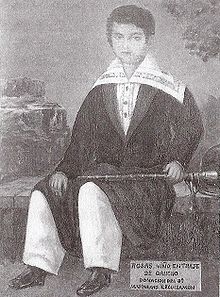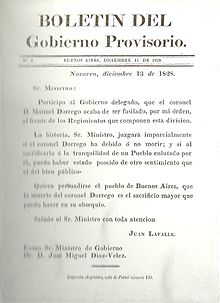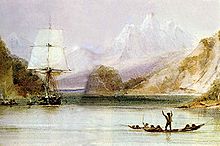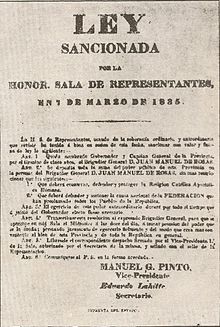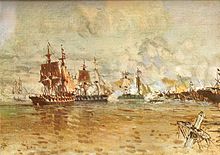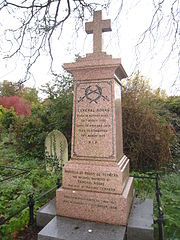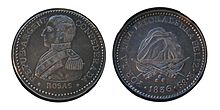- Juan Manuel de Rosas
-
Juan Manuel de Rosas 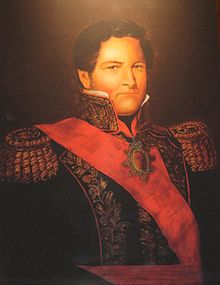
17th Governor of Buenos Aires Province In office
March 7, 1835 – February, 3 1852Preceded by Manuel Vicente Maza Succeeded by Vicente López y Planes 13th Governor of Buenos Aires Province In office
December 8, 1829 – December 17, 1832Preceded by Juan José Viamonte Succeeded by Juan Ramón Balcarce Personal details Born Juan Manuel José Domingo Ortiz de Rozas y López de Osornio
March 30, 1793
Buenos Aires, ArgentinaDied March 14, 1877 (aged 83)
Southampton, United KingdomNationality Argentina Political party Federal Party Spouse(s) Encarnación Ezcurra Religion Catholicism Signature 
Military service Allegiance Viceroyalty of the Río de la Plata, Argentine Confederation Rank Brigadier Unit Regiment of Migueletes Commands Militias of Buenos Aires Battles/wars British invasions of the Rio de la Plata, Battle of Márquez Bridge, Battle of Caseros Juan Manuel de Rosas (born Juan Manuel José Domingo Ortiz de Rozas y López de Osornio; March 30, 1793 – March 14, 1877), was an argentine militar and politician, who was elected governor of the province of Buenos Aires in 1829 to 1835, and then of the Argentine Confederation from 1835 until 1852.[1][2][3][4][5][6][7][8][9][10] He was forced to resign after his defeat at the Battle of Caseros against an army gathered by Justo José de Urquiza.
Contents
Biography
Early life
He was the son of León Ortiz de Rosas y de la Cuadra and wife Agustina Teresa López de Osornio. Born to one of the wealthiest families in the Río de la Plata region, Rosas ran away from home at a young age and began working in the fields of his cousins Juan José and Nicolás Anchorena. He modified his last name from "Rozas" to "Rosas" and removed the "Ortiz" part of it. At the age of 13, he fought during the British invasions of the Rio de la Plata, joining the forces led by Santiago de Liniers that drove the British out of Buenos Aires.[11] He also fought during the second ill-fated British invasion, joining the Regiment of Migueletes.
After that, he resumed working in the fields as an arriero, driving cattle through the immense pampas. When he was twenty-two, he created a business with Juan Nepomuceno Terrero and Luis Dorrego (brother of Manuel Dorrego) which immediately flourished. He married on March 16, 1813, shortly before turning 20 the almost 18-year-old María de la Encarnación de Ezcurra y Arguibel. They had one child, a daughter Manuela Robustiana de Rosas y Ezcurra, born in Buenos Aires on May 24, 1817. Manuela eventually married the son of Juan Terrero. Rosas' businesses benefited when the Supreme Director Juan Martín de Pueyrredón ordered the closing of salt-meat plants, which allowed him to buy 300,000 hectares of land.
He combined a strict discipline with the gauchos under his command by sharing their conduct and customs, and by subjecting himself to the same discipline he demanded from them. The territories of Rosas were next to those of the pampas, the Tehuelches and Ranqueles, so his gauchos were organized as a military force to resist malones.
Rosas joins the Civil War
In 1820, during the Brazilian invasion of the Banda Oriental, provincial caudillos Estanislao López and Francisco Ramírez joined forces and advanced on Buenos Aires. The Supreme Director José Rondeau requested José de San Martín and Manuel Belgrano to return to Buenos Aires with the Army of the Andes and the Army of the North, but San Martín stayed in Peru to keep fighting against the Royalists, and the Army of the North mutinied to avoid joining the Argentine Civil War. Buenos Aires had weak local defenses, which were defeated during the battle of Cepeda. The authority of the Supreme Directors was terminated.
Ranchers feared that the ongoing events would lead to anarchy, and organized a regiment of gauchos to face the situation. Rosas was trusted to lead them. He promoted the designation of Martín Rodríguez as governor of Buenos Aires, and negotiated with López his return to Santa Fe in exchange of 25,000 cattle. This started a strong relation between Rosas and López, which lasted for years.
Years later, Bernardino Rivadavia resigned as president of Argentina, incapable of securing the military victory in the Argentina-Brazil War, and Manuel Dorrego was chosen as governor of Buenos Aires. Under his rule, Rosas would be promoted to commander of the militias of Buenos Aires. However, the armies returning from Brazil turned against Dorrego, and Juan Lavalle executed him and conducted a coup against the government of Buenos Aires. The Unitarians started a reign of terror, aiming to destroy all Federalists. In 1829, because of higher death rates than births the demographic growth was negative. During that time, José de San Martín had returned from Europe, but disgusted with the new political situation, he refused to leave the ship and returned to Europe.
The other provinces did not recognize Lavalle as a legitimate governor, and supported the Rosist resistance instead. Lavalle was defeated a short time later at the Battle of Márquez Bridge by the forces of Rosas and López. López returned to Santa Fe, which was menaced by José María Paz, while Rosas kept Lavalle under siege and forced him to resign with the Cañuelas pact. Juan José Viamonte was designated as governor, and the legislature removed during Lavalle's revolution was restored. This legislature then elected Rosas as governor.
First government
 Rosas' strict authority prevented the country from falling into anarchy.
Rosas' strict authority prevented the country from falling into anarchy.
As a governor, Rosas ruled with strict authority. He considered that, given the social segregation of the Argentine Confederation at the time, it was the only way to keep it together and prevent anarchy.
“ The King can be compared with a father, and reciprocally a father can be compared with the King, and then set the duties of the monarch by those of the parental authorithy. Love, govern, reward and punish is what a King and a father must do. In the end, there's nothing less legitimate than anarchy, which removes property and security from the people, as force becomes then the only right. ” Rosas faced opposition from the unitarian provinces in the north. José María Paz, after defeating Facundo Quiroga at the battle of Tablada, took control of Cordoba province and started a reign of terror to destroy all federals in the zone, similar to the one started by Lavalle in Buenos Aires. The newspaper "La Gaceta" numbered the victims of the unitarian terror as 2,500 victims. Paz expanded his influence by creating the Unitarian League, while Rosas created the Federal Pact instead. The plans of Paz would fail when his horse was taken down and he was captured. Federalist José Vicente Reinafé, close to López, replaced him as governor of Córdoba. Córdoba, Santiago del Estero, La Rioja and the provinces of Cuyo joined the Federal Pact in 1831, Catamarca, Tucumán and Salta did so the following year. As for Paz himself, he was held captive by Estanislao López, who refused to execute him. He requested Rosas to check that it was the will of all the provinces to execute Paz, but Rosas did not accept the request. He considered that the fate of Paz should be decided solely by López, who held him prisoner.
One of the keys to the economic supremacy of Buenos Aires was its monopoly over the port and customs of Buenos Aires, the only one linking the Confederation with Europe. Rosas refused to lift control over it, considering that Buenos Aires faced alone the international debt that was generated by the Argentine War of Independence and the Argentina-Brazil War.
The defeat of Paz and the expansion of the Federal Pact further ushered in a period of economic and political stability. As a result, Federalists were divided between two political trends: those who wanted the calling of a Constituent Assembly to write a Constitution, and those who supported Rosas in delaying it. Rosas thought that the best way to organize the Argentine Confederation was as a federation of federated states, similar to the successful States of the United States; each one should write its own local constitution and organize itself, and a national constitution should be written at the end, without being rushed.
He had a successful and popular first term, but refused to run for a second even though public support was strong.[12]
First Conquest of the Desert
After his resignation as governor, Rosas left Buenos Aires and started the first Conquest of the Desert, to expand and secure the farming territories and prevent indigenous attacks. Rosas was aware that malones were not done because of evil desires but because of the lacking lifestyle condition of the indigenous peoples.[citation needed] As a result, he had preference for a policy of doing pacts or giving gifts or bribes to the caciques before employing military force. The hostile ranquel cacique Yanquetruz was replaced by Payné, who became a Rosas ally. Juan Manuel, in turn, adopted his son and raised him at his estancia. The pehuenche Cafulcurá was made colonel and allowed to distribute large numbers of gifts among his people; in turn, he made the compromise of not making any more malones. On the other hand, caciques like the pehuenche Chocorí who defied Rosas were defeated.
Charles Darwin met Rosas in 1833, and wrote about it in The Voyage of the Beagle. He was at Carmen de Patagones and knew that Rosas was located nearby, close to the Colorado River. He had heard about him from before, so he moved to meet him. He described him as a man of extraordinary character, a perfect horseman who conformed to the dress and habits of the Gauchos and "has a most predominant influence in the country, which it seems he will use to its prosperity and advancement".[13] Darwin included a story of how Rosas had himself put in the stocks for inadvertently breaking his own rule of not wearing knives on Sundays. This appealed to his men's sense of egalitarianism and justice. Darwin also described an anecdote about a pair of buffoons.
By the end of the first Conquest of the Desert, Buenos Aires increased its lands by thousands of square kilometers, which were distributed among new and older hacendados. The natives did not make any more malones, accepted to provide military aid to Rosas in case of need, and stayed in peaceful terms for all the remainder of Rosas' government.
Even being absent, the political influence of Rosas in Buenos Aires was still strong, and his wife Encarnación Ezcurra was in charge of keeping good relations with the peoples of the city. On October 11, 1833, the city was filled with announcements of a trial against Rosas. A large number of gauchos and poor people made the Revolution of the Restorers, a demonstration at the gates of the legislature, praising Rosas and demanding the resignation of governor Juan Ramón Balcarce. The troops organized to fight the demonstration mutinied and joined it. The legislature finally gave up the trial, and a month later ousted Balcarce and replaced him with Juan José Viamonte. The Revolution also led to the creation of the Sociedad Popular Restauradora, also known as "Mazorca".
Second government
The weak governments of Balcarce and Viamonte led the legislature to request Rosas to take the government once more. For doing so he requested the sum of public power, which the legislature denied four times. Rosas even resigned as commander of militias to influence the legislature. The context changed with the social commotion generated by the death of Facundo Quiroga, responsibility for which is disputed (different authors attribute it to Estanislao López, the Reinafé brothers, or Rosas himself). The legislature accepted then to give him the sum of public power. Even so, Rosas requested confirmation on whenever the people agreed with it, so the legislature organized a referendum about it. Every free man within the age of majority living in the city was allowed to vote for "Yes" or "No": 9.316 votes supported the release of the sum of public power on Rosas, and only 4 rejected it. There are divided opinions on the topic: Domingo Faustino Sarmiento compared Rosas with historical dictators, while José de San Martín considered that the situation in the country was so chaotic that a strong authority was needed to create order.
Although slavery was not abolished during Rosas' rule, Afro Argentines had a positive image of him. He allowed them to gather in groups related to their African origin, and financed their activities. Troop formations included many of them, because joining the army was one of the ways to become a free negro, and in many cases slave owners were forced to release them to strengthen the armies. There was an army made specifically of free negros, the "Fourth Battalion of Active Militia". The liberal policy towards slaves generated controversy with neighbouring Brazil, because fugitive Brazilian slaves saw Argentina as a safe haven: they were recognized as free men at the moment they crossed the Argentine borders, and by joining the armies they were protected from persecution of their former masters.
The people who opposed Rosas formed a group called Asociacion de Mayo or May Brotherhood. It was a literary group that became politically active and aimed at exposing Rosas' actions. Some of the literature against him includes The Slaughter House, Socialist Dogma, Amalia and Facundo. Meetings which had high attendance at first soon had few members attending out of fear of prosecution. Rosas' opponents during his rule were dissidents, such as José María Paz, Salvador M. del Carril, Juan Bautista Alberdi, Esteban Echeverria, Bartolomé Mitre and Domingo Faustino Sarmiento.[12] Rosas political opponents were exiled to other countries, such as Uruguay and Chile.
First French blockade
Main article: French blockade of the Río de la Plata Uruguayan president Manuel Oribe, ousted by the rebel Fructuoso Rivera. Rosas recognized him as the legitimate Uruguayan president, and sought to restore him in power.
Uruguayan president Manuel Oribe, ousted by the rebel Fructuoso Rivera. Rosas recognized him as the legitimate Uruguayan president, and sought to restore him in power.
The Peru–Bolivian Confederation declared the War of the Confederation against Argentina and Chile. Its protector Andrés de Santa Cruz supported European interests in South America, as well as the Unitarians, whereas Rosas and the Chilean Diego Portales did not. As a result, France gave full support to Santa Cruz in this war. Britain also supported Santa Cruz, but only by diplomatic means. Trusting in the military power at his disposal, Santa Cruz declared war against both countries at the same time. Initially, the Peruvian-Bolivian forces had the advantage, and captured and executed Portales. The war did not develop favorably for Argentina in the north, and the French Roger moved to Buenos Aires to request the surrender of Argentina. He demanded that two French citizens be released from prison, that two more be exempted from military service, and that France receive the same commercial privileges as granted by Bernardino Rivadavia to Britain. Although the demands themselves were not onerous, Rosas considered that they would set a precedent for further French interference in the internal affairs of Argentina, and refused to comply. As a result, France started a naval blockade against Buenos Aires.
Rosas took advantage of British interests in the zone: minister Manuel Moreno pointed out to the British Foreign Office that commerce between Argentina and Britain was being harmed by the French blockade, and that it would be a mistake for Britain to support it. The French judged that the people would seize the opportunity to stand against Rosas, but underestimated his popularity. With the nation being threatened by two European powers as well as two neighbouring countries allied with them, internal patriotic loyalty increased to the point that even some notable Unitarians who had fled to Montevideo returned to the country to offer their military help, such as Soler, Lamadrid and Espinosa. Things became more complicated for France as time passed: Andrés Santa Cruz was weakening, the strategy employed by Moreno was bearing fruit, and the French themselves started to have doubts about maintaining a conflict that they had expected to be quite short. Also, Britain would not allow the French to deploy troops, as they did not want a European competitor gaining territorial strength in the zone. Domingo Cullen, governor of Santa Fe replacing the ill López, considered that Rosas had nationalized a conflict that involved just Buenos Aires, and proposed to the French that they should encourage Santa Fe, Córdoba, Entre Ríos and Corrientes to secede, creating a new country that would obey them, if this new country would be spared the naval blockade. Also, Manuel Oribe, president of Uruguay and allied with Rosas, was ousted by Fructuoso Rivera with French aid. France wanted Rivera and Cullen to join forces and take Buenos Aires, while their ships kept the blockade. This alliance did not take place, as Juan Pablo López, brother of Estanislao López, defeated Cullen and drove him away from the province. Also, Andrés Santa Cruz was defeated by Chile in the Battle of Yungay, and the Peru–Bolivian Confederation ceased to exist. Now Rosas was free to focus all his attention on the French blockade.
His wife Encarnación died in Buenos Aires on October 20, 1838.
Rivera was urged by France to take military action against Rosas, but he was reluctant to do so, considering that the French underestimated his strength, even more after Santa Cruz's defeat. As a result, they elected Juan Lavalle to lead the attack, who asked not to share command with Rivera. As a result, each led his own army. His imminent attack was backed up by conspiracies in Buenos Aires, which were discovered and aborted by the Mazorca. Manuel Vicente Maza and his son were among the conspirators, and were executed as a result. Pedro Castelli also organized an ill-fated demonstration against Rosas, and was executed as well. Rosas did not wait to be attacked, and ordered Pascual Echagüe to cross the Parana river and move the fight to Uruguay. The Uruguayan armies split: Rivera returned to defend Montevideo, and Lavalle moved to Entre Ríos alone. He expected that local populations would join him against Rosas and increase his forces, but he found severe resistance, so he moved to Corrientes. Ferré defeated López, and Rivera defeated Echagüe, leaving Lavalle a clear path towards Buenos Aires. However, by that point France had lost faith in the effectiveness of the blockade, as what had been thought would be an easy and short conflict was turning into a long, possibly unwinnable, war. France started to negotiate for peace with the Confederation, and removed financial support from Lavalle. He found no help from local towns either, and there was strong desertion in his ranks. Buenos Aires was ready to resist Lavalle's attack, but his lack of support forced him to withdraw.
The civil war continues
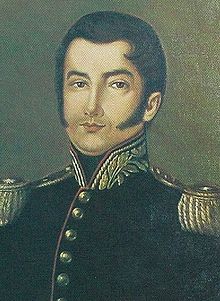 Rosas and López spared the life of José María Paz, but he broke his oath and took arms against them after escaping from prison.
Rosas and López spared the life of José María Paz, but he broke his oath and took arms against them after escaping from prison.
The unitarians and colorados (federalists) kept up their hostilities against Rosas, even after the defeat of France. The new plan was that Ferré and Rivera, in Corrientes and Uruguay, would create a new army, while Lavalle and Lamadrid moved to the north. Lavalle would move to La Rioja and distract the Federal armies, while Lamadrid organized another army at Tucumán. By this time José María Paz had escaped from his imprisonment. Rosas spared his life because he had sworn never to attack the Confederation again, but he broke his oath. His presence benefited the anti-Rosas forces, but also generated internal strife: Ferré gave him the command of the armies of Corrientes, which Rivera did not like. Rivera even accused Paz of being a spy of Rosas. Nevertheless, the combined forces of Paz, Rivera and unitarian ships at the river had the federal forces of Echague at Santa Fe surrounded. To counter the unitarian naval supremacy Guillermo Brown organized a naval squadron; it defeated captain Coe at Santa Lucía.
Oribe defeated the forces of Lavalle at La Rioja, but Lavalle himself managed to escape to Tucuman. Lamadrid attacked San Juan, but was completely defeated. At Tucuman Oribed defeated Lavalle, who barely escaped with a group of 200 men to the north; he was killed shortly after in a confusing episode. This ended the anti-Rosas threat in the Argentine northwest.
Rivera threatened to end their alliance if Ferré insisted in favoring Paz. Rivera wanted to annex the Riograndense Republic (part of Rio Grande do Sul, that had declared independence from Brazil and was fighting the War of the Farrapos) and the Argentine mesopotamia into a projected Federation of Uruguay, but Paz was against that. Paz defeated Echague, and Rivera defeated the new federal governor of Entre Ríos, Justo José de Urquiza. Federalist Juan Pablo López from Santa Fe changed sides to the unitarian ranks.
Rosas was again in a weak position, and would not have been able to resist an attack. But Paz, Ferré, Rivera and López had conflicting battle plans, and their armies did not move, which gave Oribe time to return from the north. The forces of Santa Fe refused to fight for the unitarians, and massive defection reduced López's armies from 2.500 men to 500. He was easily defeated at Coronda and Paso Aguirre. Ferré was finally interested in Rivera's federation, and put Paz aside. Rivera and Oribe, both considering themselves rightful presidents of Uruguay, would battle. The battle of Arroyo Grande was a decisive victory for Oribe, and Rivera barely escaped alive. The unitarian threat to Rosas had been again removed.
Anglo-French blockade
Main article: Anglo-French blockade of the Río de la PlataAfter the victory of Oribe at Arroyo Grande, Britain and France intervened in the conflict. Their ambassadors, Mandeville and De Lurde, demanded that Rosas retreat from Uruguayan territory. Rosas did not reply, and ordered Brown to support Oribe by blockading Montevideo. British commodore John Brett Purvis attacked the Argentine navy, taking over the vessels. Mandeville and De Lurde were replaced by Ousley and Deffaudis. The public purposes of the Anglo-French intervention were to protect the Uruguayan independence against Oribe, defend the recently-proclaimed independence of Paraguay, and end the civil wars in the La Plata River region. But there were also secret purposes: to turn Montevideo into a "commercial factory", to force the free navigation of the rivers, to turn the Argentine Mesopotamia into a new country, to set the borders of Uruguay, Paraguay and the Mesopotamia (without Brazilian intervention), and to help the anti-rosists to depose the governor of Buenos Aires and install one loyal to the European powers instead.[citation needed]
The European powers needed a convincing argument to justify a declaration of war. To this end, Florencio Varela requested that former Federalist José Rivera Indarte write a list of crimes that Rosas could be blamed for. The French firm Lafone & Co paid him with a penny for each death listed. The list, named Blood tables, included deaths caused by military actions of the unitarians (including Lavalle's invasion of Buenos Aires), soldiers shot during wartime because of mutiny, treason or espionage, victims of common crimes and even people who were still alive. He also listed Nomen nescio (NN) deaths (unidentified people); some entries were listed more than once. He also blamed Rosas for the death of Facundo Quiroga. With all this, Indarte listed 480 deaths, and was paid with two pounds sterling (about £140 in 2011 based on the retail price index, or £1500 based on average earnings[14]). He tried to add to the list 22,560 deaths, the number caused by military conflicts in Argentina from 1829 to that date, but the French refused to pay for them. Indarte wrote in his libel that "it is a holy action to kill Rosas". Lafone & Co, who paid for the Blood tables, had control of Uruguayan customs, and would have greatly benefited from a new blockade of Buenos Aires.[citation needed] In March 1841, Indarte was the mastermind behind a failed bid against Rosas life, which consisted in sending him a firing device concealed in a diplomatic box, known as La Máquina Infernal ("The Infernal Machine").[15]
Giuseppe Garibaldi, commanding an Italian group, started hostilities by occupying Colonia del Sacramento and Isla Martín García, and led the controversial sack of Gualeguaychú. With the Uruguay river secured, the Anglo-French navy intended to control the Paraná river as well. Worried by the gravity of the danger, Rosas instructed Lucio Mancilla to fortify a section of the Parana to prevent the foreign navy from going any further. A similar study had been made years earlier by Hipólito Vieytes during the Argentine War of Independence, finding that a good strategic point was in Obligado.
An Anglo-French a convoy of three steamboats, many armed sailboats, and 90 merchant ships sailed up the Parana. Mansilla fortified Obligado with artillery, and closed the river with chains. The battle of Vuelta de Obligado took many hours, and the navy finally forced their way through. However, 38 merchant ships returned to Montevideo, and word of the unequal fight generated support for Rosas across most of South America. Mansilla continued the attack at San Lorenzo and Quebracho. The expedition was a commercial failure, and the second battle at Quebracho during the return of the ships finally eliminated them.
After long negotiations, Britain, and then France, surrendered and lifted the blockade. Both countries made a 21-gun salute to the flag of Argentina.
Decline and fall
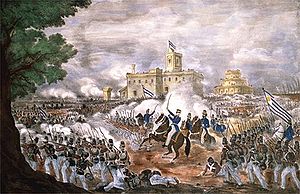 Rendition of the Battle of Caseros, February, 1852. Rosas' defeat at Caseros resulted in his overthrow and exile.
Rendition of the Battle of Caseros, February, 1852. Rosas' defeat at Caseros resulted in his overthrow and exile.
General Urquiza, who was governor of the Entre Ríos Province and once backed Rosas, organized an army against him. Other provinces as well as Brazil and Uruguay joined the fight to take down the dictator.[12] On February 3, 1852, Rosas was overthrown when his army was defeated at the Battle of Caseros. After Caseros battle Rosas spent the rest of his life in exile, in the United Kingdom, as a farmer in Southampton. He was initially buried in the Southampton Old Cemetery in Southampton Common until his body was exhumed in 1989 and transferred to the La Recoleta Cemetery in Argentina.
Rosas received the 'combat sable' from General San Martin, 'maximum hero' of Argentina, who judged that Rosas was the only man capable of defending Argentina against the European powers, especially the British.
Memorial in Southampton Old Cemetery.
Criticism and historical perspective
See also: Day of National SovereigntyThe figure of Juan Manuel de Rosas and his government generated strong conflicting viewpoints, both in his own time and afterwards.
In the context of the Argentine Civil War, Rosas was the main leader of the Federalist party, and as such the most part of the controversies around him were motivated by the preexistent antagonism of Federalism with the Unitarian Party. During the government of Rosas most unitarians fled to neighbour countries, mostly to Chile, Uruguay and Brazil; among them we can find Domingo Faustino Sarmiento, who wrote Facundo while living in Chile. Facundo is a critic biography of Facundo Quiroga, another federalist caudillo, but Sarmiento used it to pass many indirect or direct critics to Rosas himself. Some members of the 1837 generation, such as Esteban Echeverría or Juan Bautista Alberdi, tried to generate an alternative to the unitarians-federalists antagonism, but had to flee to other countries as well.
After the defeat of Rosas in Caseros and the return of his political adversaries, it was decided to portray him in a negative light. The legislature of Buenos Aires charged him with High treason in 1857; Nicanor Arbarellos supported his negative vote with the following speech:
“ Rosas, Sir, that tyrant, that barbarian, even if barbarian and cruel, was not considered as such by the European and civilized nations, and that judgment of the European and civilized nations, moved to posterity, will hold in doubt, at least, that barbarian and execrable tyranny that Rosas exercised among us. It's needed, then, to mark with a legislative sanction declaring him guilty of lèse majesté so at least this point is marked in history, and it is seen that the most potent court, which is the popular court, which is the voice of the sovereign peoples by us represented, throws to the monster the anathema calling him traitor and guilty of lèse majesté. Judgments like those must not be left for history.
What will be said, what might be said in history when it's seen that the civilized nations of the world, for whom we are but just a point, have acknowledged in this tyrant a being worthy to deal with them? That England has returned his cannons taken in war action, and saluted his bloody and innoent-blood stained flag with a 21-gun salute? This fact, known by history, would be a great counterweight, sir, if we leave Rosas without this sanction. The France itself, which started the crusade that was shared by general Lavalle, in its due time also abandoned him, dealed with Rosas and saluted his flag with a 21-gun salute. I ask, sir, if this fact won't erase from history everything we may say, if we leave this monster that decimated us for so many years without a sanction.
The judgment of Rosas must not be left to history, as some people desire. It's clear that it can't be left to history the judgment of the tyrant Rosas. Let's throw to Rosas this anathema, which perhaps can be the only one to harm him in history, because otherwise his tyranny will always be doubtful, as well as his crimes! What will be said in history, sir? And this is sad to tell, what will be said in history when it is said that the brave Admiral Brown, the hero of the Navy of the Independence war, was the admiral who defended the tyranny of Rosas? What will be said in history without this anathema, when it is said that this man who contributed with his glories and talents to give shine to the Sun of May, that the other deputee referenced in his speech, when it is said that General San Martín, the conqueror of the Andes, the father of the Argentine glories, made him the greatest tribute that can be given to a soldier by handing him his sword? Will this be believed, sir, if we don't throw an anathema to the tyrant Rosas? Will this man be known as he is in 20 or 50 years, if we want to go further, when it is known that Brown and San Martín were loyal to him and gave him the most respectful tributes, along with France and England?
No, sir: they will say, the savage unitarians, his enemies, lied. He has not been a tyrant: far from that, he has been a great man, a great general. It's needed to throw without doubts this anathema to the monster. If at least we had imititated the English people, who dragged the corpse of Cromwell across the streets of London, and had dragged Rosas across the streets of Buenos Aires! I support, Mr. President, the project. If the judgment of Rosas was left to the judgment of history, we won't get Rosas to be condemned as a tyrant, but perhaps he may be in it the greatest and most glorious of Argentines.[16]” The first historians of Argentina, such as Bartolomé Mitre, were vocal critics of Rosas, and for many years there was a clear consensus in condemning him. However, authors like Mitre or Sarmiento can't be considered exclusiely from the perspectives of historiography or the history of ideas, as they were active people and even protagonists of the political struggles of their time; and their works were used as tools to advertise their political ideas.[17] Adolfo Saldías was the first in not condemning Rosas entirely, and in the book Historia de la Confederación Argentina he supported his international policy, while keeping the usual rejection on the treatment given by Rosas to detractors. Authors like Levene, Molinari or Ravignani, in the 1930 decade, would develop a neutral approach to Rosas, that Ravignani defined as "Nor with Rosas, nor against Rosas".[18] Their work would be more oriented towards the positive things of the early years of Rosas, and less into the most polemic ones.[18]
Years later, a new historiographical flow made an active and strong support of Rosas and other caudillos. Because of its great differences with the early historians the local historiography knows them as revisionists, while the early one is named "official" or "academic" instead. However, despite namings, the early historiography of Argentina hasn't always followed standard academic procedures, nor developed hegemonic views at all topics.[19] They would expand the work of Saldías and Ernesto Quesada, and developed instead negative views about Mitre, Sarmiento, Rivadavia and the unitarians.
Modern historians like Felipe Pigna or Félix Luna avoid joining the dispute, describing instead the existence of conflicting viewpoints towards Rosas. The historiographical dispute about Rosas is currently considered to be over.[20][21]
Legacy
 banknote of 20 Argentine pesos, featuring Rosas.
banknote of 20 Argentine pesos, featuring Rosas.
The date of November 20, anniversary of the battle of Vuelta de Obligado, has been declared "Day of National Sovereignty" of Argentina, following a request by revisionist historian José María Rosa.[22][23] This observance day was raised in 2010 to a public holiday by Cristina Fernández de Kirchner.[24] Rosas has been included in the banknotes of 20 Argentine pesos, with his face and his daughter Manuela Rosas in the front and a depiction of the battle of Vuelta de Obligado in the back. A monument of Rosas, 15 meters tall and with a weight of 3 tons, has been erected in 1999 in the city of Buenos Aires, at the conjunction of the "Libertador" and "Sarmiento" avenues.[25]
The aforementioned law that charged Rosas of high treason was abrogated in 1974.
A portrait of Rosas was included in 2010 in a gallery of Latin American patriots, held at the Casa Rosada. The gallery, which included works provided by the presidents of other Latin American countries, was held because of the 2010 Argentina Bicentennial.[26]
Silver and gold coins were struck during Rosas' tenure both with his portrait and without, but bearing his name. Portrait coins were issued in 1836 with a more youthful portrait and again in 1842 with a more mature portrait. Shown at right is a silver 8 soles (approx. 39 mm) coin from 1836.
See also
- Argentine Civil War
- List of heads of state of Argentina
Footnotes
- ^ Lynch 2006, pp. 1, 24.
- ^ Reid 2007, p. 66.
- ^ Edwards 2008, p. 27.
- ^ Centeno 2002, p. 54.
- ^ Beisner 2003, p. 339.
- ^ Lewis 2003, p. 207.
- ^ Needell 2006, p. 121.
- ^ Hodge 2008, p. 43.
- ^ Richard 2010, p. 26.
- ^ Lewis 2006, p. 84.
- ^ Secretos de la última invasión inglesa (Spanish)
- ^ a b c Crow
- ^ Chapter IV: Rio Negro To Bahía Blanca
- ^ Historical value of money converter
- ^ La Máquina Infernal (Spanish)
- ^ Rosa, José María. Historia Argentina, V. Buenos Aires. pp. 491. "Spanish: Rosas, señor, ese tirano, ese bárbaro, así bárbaro y cruel, no era considerado lo mismo por las naciones europeas y civilizadas, y ese juicio de las naciones europeas y civilizadas, pasando a la posteridad, pondrá en duda, cuando menos, esa tiranía bárbara y execrable que Rosas ejerció entre nosotros. Es necesario, pues, marcar con una sanción legislativa declarándole reo de lesa patria para que siquiera quede marcado este punto en la historia, y se vea que el tribunal más potente, que es el tribunal popular, que es la voz del pueblo soberano por nosotros representado, lanza al monstruo el anatema llamándole traidor y reo de lesa patria... Juicios como éstos no deben dejarse a la historia... ¿Qué se dirá, qué se podrá decir en la historia cuando se viere que las naciones civilizadas del mundo, para quien nosotros somos un punto... han reconocido en ese tirano un ser digno de tratar con ellos?, ¿que la Inglaterra le ha devuelto sus cañones tomados en acción de guerra, y saludado su pabellón sangriento y manchado con sangre inocente con la salva de 21 cañonazos?... Este hecho conocido en la historia, sería un gran contrapeso, señor, si dejamos a Rosas sin este fallo. La Francia misma, que inició la cruzada en que figuraba el general Lavalle, a su tiempo también lo abandonó, trató con Rosas y saludó su pabellón con 21 cañonazos... Yo pregunto, señor, si este hecho no borrará en la historia todo lo que podamos decir, si dejamos sin un fallo a este monstruo que nos ha diezmado por tantos años... No se puede librar el juicio de Rosas a la historia, como quieren algunos... Es evidente que no puede librarse a la historia el fallo del tirano Rosas... ¡Lancemos sobre Rosas este anatema, que tal vez sea el único que puede hacerle mal en la historia, porque de otro modo ha de ser dudosa siempre su tiranía y también sus crímenes... ¿Qué se dirá en la historia, señor?, y esto sí que es hasta triste decirlo, ¿qué se dirá en la historia cuando se diga que el valiente general Brown, el héroe de la marina en la guerra de la independencia, era el almirante que defendió los derechos de Rosas? ¿Qué se dirá en la historia sin este anatema, cuando se diga que este hombre que contribuyó con sus glorias y talentos a dar brillo a ese sol de Mayo, que el señor diputado recordaba en su discurso, cuando se diga que el general San Martín, el vencedor de los Andes, el padre de las glorias argentinas, le hizo el homenaje más grandioso que puede hacer un militar legándole su espada? ¿Se creerá esto, señor, si no lanzamos un anatema contra el tirano Rosas? ¿Se creerá dentro de 20 años o de 50, si se quiere ir más lejos, a ese hombre tal como es, cuando se sepa que Brown y San Martín le servían fieles y le rendían los homenajes más respetuosos a la par de la Francia y de la Inglaterra? No, señor: dirán, los salvajes unitarios, sus enemigos, mentían. No ha sido un tirano: lejos de eso ha sido un gran hombre, un gran general. Es preciso lanzar sin duda ninguna ese anatema sobre el monstruo... ¡Ojalá hubiéramos imitado al pueblo inglés que arrastró por las calles de Londres el cadáver de Cromwell, y hubiéramos arrastrado a Rosas por las calles de Buenos Aires!... Yo he de estar, señor Presidente, por el proyecto. Si el juicio de Rosas lo librásemos al fallo de la historia, no conseguiremos que Rosas sea condenado como tirano, y sí tal vez que fuese en ella el más grande y el más glorioso de los argentinos."
- ^ Gelman, Jorge; Raúl Fradkin (2010). Doscientos años pensando la Revolución de Mayo. Buenos Aires: Sudamericana. p. 130. ISBN 978-950-07-3179-9.
- ^ a b Devoto, Fernando; Pagano, Nora (2009). Historia de la Historiografía Argentina. Buenos Aires: Editorial Sudamericana. p. 181. ISBN 978-950-07-3076-1.
- ^ Devoto, Fernando; Pagano, Nora (2009). Historia de la Historiografía Argentina. Buenos Aires: Editorial Sudamericana. p. 202. ISBN 978-950-07-3076-1.
- ^ "Puede decirse que hoy ya se ha publicado toda la documentación importante relativa a Rosas y su tiempo. No cabe esperar que aparezcan papeles que puedan volcar los juicios formulados por las distintas corrientes historiográficas. Incluso es dable afirmar que el tema de Rosas ha perdido interés para la mayoría de los historiadores argentinos". Luna, p.47
- ^ "Apaciguada como hoy está la disputa tradicional en torno de la figura de Rosas, el debate histórico acalorado parace haberse desplazado a 1910". Mendelevich, p. 86
- ^ H.Cámara de diputados de la Nación
- ^ Día de la soberanía nacional
- ^ Por decreto, el Gobierno incorporó nuevos feriados al calendario (Spanish)
- ^ Emplazaron en Palermo una estatua de Juan Manuel de Rosas
- ^ Galería de los Patriotas Latinoamericanos abrió ante siete presidentes (Spanish)
References
- Centeno, Miguel Angel (2002). Blood and Debt: War and the Nation-State in Latin America. University Park: The Pennsylvania State University Press. ISBN 978-0271023069.
- Edwards, Todd L. (2008). Argentina: a global studies handbook. Santa Barbara: ABC-CLIO. ISBN 978-1-85109-986-3.
- Hodge, Carl Cavanagh (2008). Encyclopedia of the Age of Imperialism, 1800-1914: A-K. Westport: Greenwood Press. ISBN 978-0313334061.
- Lewis, Daniel K. (2003). The history of Argentina. New York: Palgrave Macmillan. ISBN 978-0742537392.
- Lewis, Paul H. (2006). Authoritarian regimes in Latin America: dictators, despots, and tyrants. Lanham: Rowman & Littlefield Group. ISBN 978-0742537392.
- Luna, Félix (2003). La época de Rosas. Buenos Aires: Grupo Editorial Planeta. ISBN 950-49-1116-1.
- Lynch, John (2006). Argentine caudillo: Juan Manuel de Rosas. Lanham: SR books. ISBN 0842028986.
- Mendelevich, Pablo. (2010). El Final. Buenos Aires: Ediciones B. ISBN 978-987-627-166-0.
- Needell, Jeffrey D. (2006). The Party of Order: the Conservatives, the State, and Slavery in the Brazilian Monarchy, 1831–1871. Stanford: Stanford University Press. ISBN 0-8047-5369-5.
- Reid, Michael (2007). Forgotten continent: the battle for Latin America's soul. Edmundsbury Press. ISBN 978-0300116168.
- Richard, J. M. (2010). The Link Persona. Durnham: Eloquent books. ISBN 978-1608604869.
External links
- Rosas en la historiografía Argentina (Spanish)
- Juan Manuel de Rosas y sus muchas huellas (Spanish)
Preceded by
Juan José ViamonteGovernor of Buenos Aires Province (Head of State of Argentina)
1829-1832Succeeded by
Juan Ramón BalcarcePreceded by
Manuel Vicente MazaGovernor of Buenos Aires Province (Head of State of Argentina)
1835-1852Succeeded by
Vicente López y PlanesHeads of state of Argentina May Revolution and Independence War Period
up to Asamblea del Año XIII (1810–1814)Supreme Directors of the United Provinces
of the Río de la Plata (1814–1820)Unitarian Republic – First Presidential Government (1826–1827) Pacto Federal and Argentine Confederation (1827–1862) Manuel Dorrego · Juan Manuel de Rosas · Juan Ramón Balcarce · Juan José Viamonte · Manuel Vicente Maza · Juan Manuel de Rosas · Justo José de Urquiza · Santiago Derqui · Juan Esteban PederneraNational Organization – Argentine Republic (1862–1880) Generation of '80 – Oligarchic Republic (1880–1916) First Radical Civic Union terms,
after Universal (Male) Suffrage (1916–1930)Infamous Decade (1930–1943) Revolution of '43 military dictatorships (1943–1946) First Peronist terms (1946–1955) Revolución Libertadora military dictatorships (1955–1958) Fragile civilian governments – Proscription of Peronism (1958–1966) Revolución Argentina military dictatorships (1966–1973) Return of Perón (1973–1976) National Reorganization Process military dictatorships (1976–1983) Return to Democracy (1983–present) Argentine Civil War (1814-1876) Parties
involved
(leaders)Federalists (José Gervasio Artigas · Mariano Vera · Estanislao López · Francisco Ramírez · Juan Bautista Bustos · Manuel Dorrego · Facundo Quiroga · Alejandro Heredia · Pascual Echagüe · Juan Manuel de Rosas · Justo José de Urquiza · Ricardo López Jordán · Felipe Varela · Chacho Peñaloza)
Unitarians (Carlos María de Alvear · Juan Martín de Pueyrredón · José Rondeau · Bernardino Rivadavia · Juan Lavalle · José María Paz · Juan Esteban Pedernera · Gregorio Aráoz de Lamadrid · Pedro Ferré · Domingo Faustino Sarmiento)Battles Cepeda (1820) · Navarro (1828) · San Roque (1829) · Márquez Bridge (1829) · La Tablada (1829) · Oncativo (1830) · Sauce Grande (1840) · Famaillá (1841) · Caaguazú (1841) · Laguna Limpia (1846) · Vuelta de Obligado (1846) · Caseros (1852) · Don Gonzalo (1873)Treaties Pilar (1820) · Benegas (1820) · Quadrilateral (1822) · Cañuelas Pact (1829) · Federal Pact (1831) · Protocol of Palermo (1852) · San Nicolás (1852) · Pact of San José de Flores (1859)See also United Provinces of the Río de la Plata · League of the Free Peoples · Arequito Revolt · Revolution of the Restorers · Federal League · Unitarian League · Argentine Confederation · Uruguayan Civil War · State of Buenos Aires · Argentine Constitution of 1853Categories:- 1793 births
- 1877 deaths
- People from Buenos Aires
- Argentine Roman Catholics
- Argentine people of Spanish descent
- Federales (Argentina) politicians
- Juan Manuel de Rosas
- Governors of Buenos Aires province
- Attempted assassination survivors
- Burials at La Recoleta cemetery
Wikimedia Foundation. 2010.

